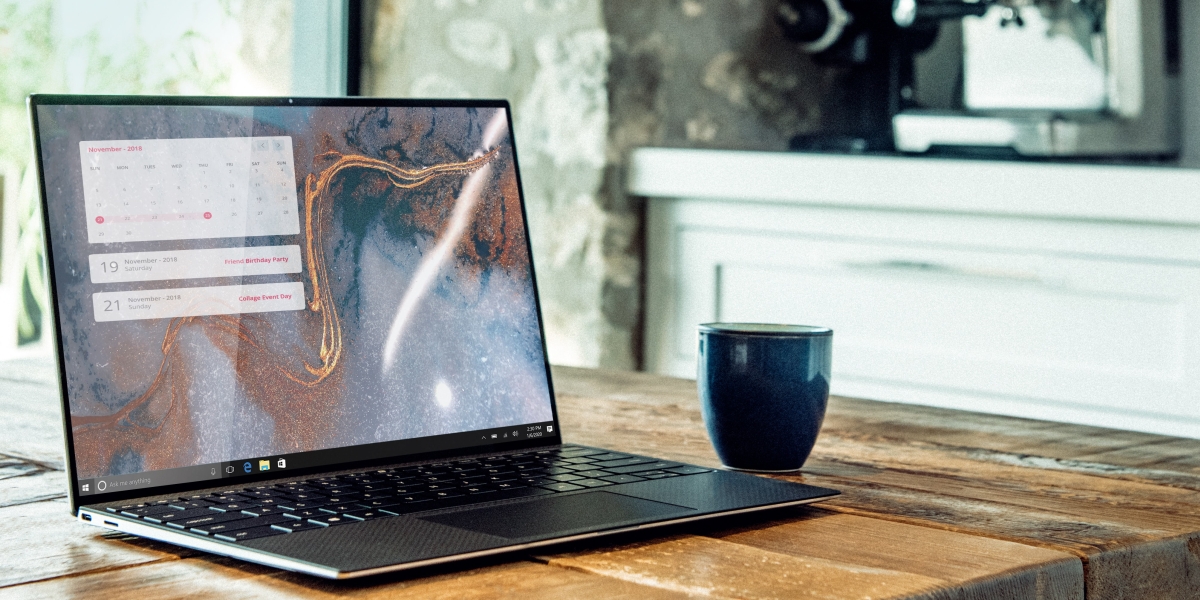A flexible, portable, and powerful ultrabook that is thin and light.
Windows-based laptops have a reputation for being uninspiring in appearance, but the Dell XPS 13 7390 2-in-1 defies such stereotypes. The XPS 13 is a tremendous productivity powerhouse, from its machined aluminum frame and ultra-thin design to its deceptively powerful components. But I was curious if all of the gushing acclaims justified the device’s astronomical price.
Specs:
- Product Name XPS 13 7390 (2020)
- Product Brand Dell
- SKU B084R5SRQP
- Price $1800
- Release Date August 2019
- Weight 6.09 lbs.
- Product Dimensions 0.51 x 11.67 x 8.17 in.
- Warranty 1 year
- Display 13.4” FHD+ 1920 x 1200 16:10 touchscreen
- Processor Intel Core i7-1065G7
- RAM 32GB
- Storage 521GB PCIe NVMe SSD
- Connectivity Wi-Fi 6, Bluetooth 5.0
- Ports 2 Thunderbolt 3.0, 3.5mm audio, microSD
- Camera 1280 x 720
Design: A marvel of minimalism
The Dell XPS 13 is everything a premium ultrabook should be. It has an exterior made of machined aviation aluminum and carbon fiber inside. It not only makes it extremely thin and light, but it also gives it firmness and durability that defies its small stature.
The XPS 13’s hinge is both smooth and robust, allowing it to turn into a tablet. When used as a laptop, you might not notice a fixed and movable hinge difference. There is no screen wobbling, and it will remain perfectly balanced where you place it.
Despite its durability, the laptop effortlessly converts to a tablet, with Windows 10 detecting the transition and converting to tablet mode.
The excellent keyboard, which is rather big for such a compact laptop and has an excellent clicky response, makes navigation a snap. The 13 2-in-1, like previous Dell XPS devices, has a beautiful trackpad that is both large and responsive and is one of the finest on any Windows laptop. Naturally, as a 2-in-1, the XPS 13 has a touchscreen, which I had no trouble using.
The power button has a fingerprint reader incorporated into it. Its weak functioning, on the other hand, disappointed me. Despite several efforts to record a print, I was unable to get it to register my fingerprint.
After investigating this problem, I discovered a possible solution. However, it requires altering BIOS settings, which I was unprepared to undertake. It’s also not a fix that you should expect of an end-user. The manufacturer should have fixed a known issue long ago on such a costly gadget.
Another annoyance is the limited number of accessible ports; nevertheless, the ones it does have are quick and flexible. The XPS 13 comes with two Thunderbolt 3 ports that provide lightning-fast data transfer speeds and serve as charging outlets.
It also comes with an adapter to connect full-size USB devices. You’ll still need a USB hub if you wish to connect more than two devices to the laptop at the same time. It also comes with a microSD card port and a 3.5mm headphone jack, which are rare these days.
Sharp and accurate display

Even though the 1920×1200 pixel display isn’t the highest resolution display available, I’ve never had reason to complain. The screen has good viewing angles and is crisp and color accurate. Although the 16:10 aspect ratio means you’ll see black bars when watching films, it dramatically enhances the XPS 13’s efficiency.
XPS 13: Setup Process
Getting started with the XPS 13 is comparable to getting started with any Windows 10 laptop. It’s a guided and straightforward process, though Dell does add a few extra stages, including one where you get prompted to sign up for McAfee antivirus. I accessed Dell SupportAssist and Windows Update once I was on the desktop to download and install several essential updates.
Selectively powerful performance
The XPS 13 has a 10th generation Intel Core i7-1065G7 CPU that packs a lot of computing power into a small body. My PCMark 10 Work 2.0 test received a score of 4,139, which appears to be attributed to poor graphical performance due to the lack of a dedicated video card.
Keep in mind, though, that the XP13 isn’t a slouch for a device with only integrated graphics, scoring 8,878 on GFXBench. That means it’ll suffice for light gaming and creative work, but don’t expect to perform any video editing on this little laptop. I was able to play DOTA 2 with acceptable frame rates at medium-low settings. It’s not the best experience, but it’ll suffice for less demanding games like this.
The laptop is blazingly quick regarding day-to-day productivity and media consumption due to its speedy SSD storage. You won’t have to worry about having too many tabs open at once with 32GB of fast DDR4 RAM.
The XPS 13 does tend to heat up quickly, but never to an intolerable level. Because there doesn’t appear to be a lot of air in the chassis, this probably limits the laptop’s potential performance.
Battery Life: Up to a day’s worth of capacity
Dell claims that the battery in the XPS 13 would last more than 10 hours, which proved entirely accurate. Of course, this will depend on how you use it, but even with a heavy load, it should last an entire workday.
Decent Camera
With just HD (1280×720) quality, the camera on the XPS 13 isn’t much to write home about, but it’s enough for calling home. It’s adequate for video conferencing and is typical of laptops. Given the fantastic quality of rear-facing cameras seen in smartphones, I’m curious why premium computers like this don’t feature better cameras.
Decent Audio for a laptop

Laptop speakers aren’t good, but the XPS 13 has surprisingly good sounds, especially for such a tiny and light device. The XPS 13 performed admirably in the mids and highs but struggled a little in the bass with the baseline music I use for audio testing (2Cellos cover of “Thunderstruck”).
It was validated by listening to various songs, including System of a Down’s heavy rock song “Protect the Land.” For streaming content on the go, the above-average Audio works well with the high-quality screen.
Fast and reliable connectivity
The XPS 13 connected to my home Wi-Fi network without issue, and its Bluetooth connection was solid and stable. It has Bluetooth 5.0 and uses the newest Wi-Fi 6 technology.
Bloatware lurks in the shadows.
The XPS 13 is powered by Windows 10, perhaps the most flexible operating system for PCs. There are a few obnoxious pre-installed apps in terms of bloatware. There’s Dropbox and Netflix, which aren’t too bad, but Dell also includes Mcafee Livesafe. Even if you prefer McAfee software, allowing customers to install such products themselves is preferable.
Dell also offers some pretty beneficial maintenance programs. I’ve been using Dell SupportAssist on my XPS 15 for years, and it’s an excellent method to keep your laptop up to date.
The cost: a significant chunk of money
The XPS 13 configuration I tested costs $1800, and even if you choose lower specifications, you won’t get better value for money. It’s crucial to remember that you’re paying for the entire ultra-portable product, not just the internal components. A large portion of the expensive price tag is justified by the beautiful design and simplicity of travel.
Pros And Cons
Pros
- Razor-thin 2-in-1 design
- Bright and beautiful display
- Comfortable and clicky keyboard
- Expansive trackpad
- Excellent battery life
- Fast and responsive hardware
Cons
- Expensive
- No dedicated GPU
- Poor fingerprint reader
- Limited port selection
The Final Verdict
Despite its high price, Dell does not overcharge for the XPS 13 7390 2-in-1. It’s a lightning-fast ultrabook with excellent build quality, despite its lack of graphics power. If you’re looking for the best products on the move, and money isn’t an issue, go no further.
yehiweb
Related posts
New Articles
What is the difference between FMWhatsApp and GBWhatsApp?
In the world of messaging apps, WhatsApp reigns supreme as one of the most popular platforms for connecting with friends…


